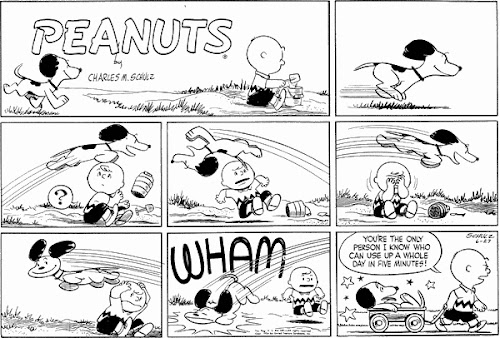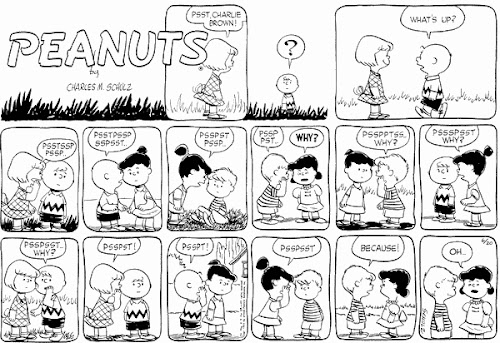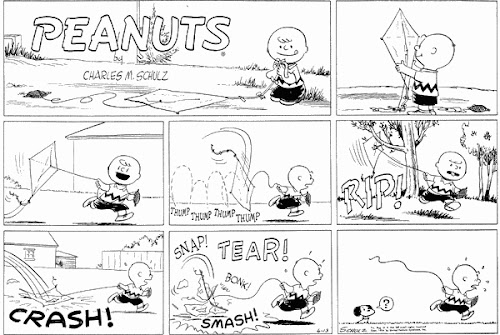June 14
No cutting and pasting here. Charles Schulz draw out every "BANG" in this strip, or I don't see any at duplicates at least.
June 15
A simple Murphy's Law type of premise. It's another look at the famous doghouse too, which implies that Snoopy must have an owner, whoever it is.
June 16gocomics.com's image for this strip is a duplicate of June 14th's. Can anyone with access to the Fantagraphics collection fill us in as to what's supposed to be here?
June 17
The drawing of Snoopy eating the ice cream scoop is rather charming.
June 18
History: Wikipedia notes "The first fusion bomb was tested by the United States in
Operation Ivy on November 1, 1952, on Elugelab Island in the Enewetak (or Eniwetok) Atoll of the Marshall Islands, code-named 'Mike.'"
This is one of my favorite early strips, it really sticks out in my memory. Lucy is extremely, panel-fillingly loud for the first time, an ominous development from the young girl. The seriousness with which Charlie Brown pushes down the plunger and Patty holds her ears is great. And of course it's a reference to the biggest damn firecrackers the human race ever made, which were new developments at the time.
As a purely random aside, the comparison, however slight, between a child and a piece of nuclear weaponry unavoidably reminded me of
this.
June 19
When you have two characters talking to each other in a comic strip, and their words are the point of the strip, it becomes necessary to have them do something with their bodies during that time. Unlike as with mere text, here a comic strip's graphic nature provides extraneous information, and could actually be distracting if not handled well, but if not considered could lead to the infamous "talking heads" effect. It happens enough, in most humor strips, that a cartoonist must make plans for it. (In dramatic strips, the quality of the drawing and the "camera angles" might be enough to sustain interest.) It is a fundamental problem for most cartoonists who hope to have careers longer than a couple of years. Bill Watterson of Calvin and Hobbes would sometimes approach talky, philosophical strips by putting the two in a wagon and sending them over a cliff; this is one of the many reasons we love Calvin and Hobbes.
Throughout Peanuts' run, characters do various things when there's a talky strip, such as walking across a field, sitting beneath a tree of standing behind The Brick Wall. There are probably thousands of such strips, and this is one of them. It is probably not the case that Schulz obsessively planned these out, but in this one at least the art serves to accentuate the conversation: the balancing in the first panel illustrates the carefree nature of the conversation, Charlie Brown hiding behind the tree shows he's anxious about his upcoming revelation, and having the characters sit at a curb in the four panel lets Schulz draw CB in an appropriately slouched pose.
One thing about this strips that has always subtly bothered me is how rapidly the characters change poses. They go from playing on the curb, to walking across a field, to a small tree, then back to a curb, over the course of a three-sentence exchange in a single conversation. Peanuts characters are not generally shown as being hyperactive, but there is a certain restlessness here.







































